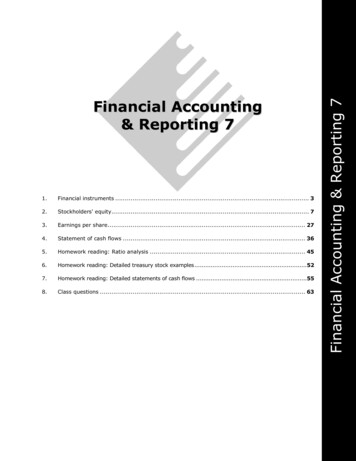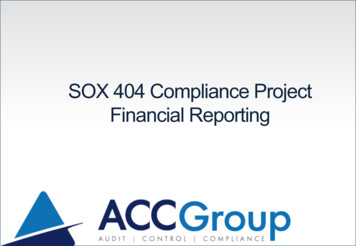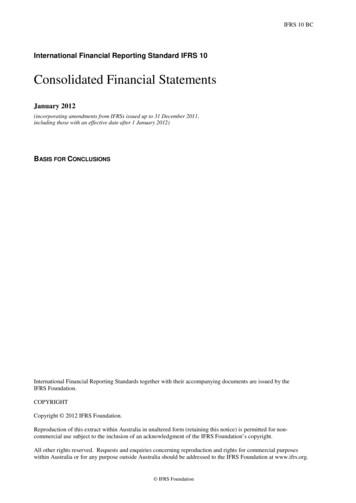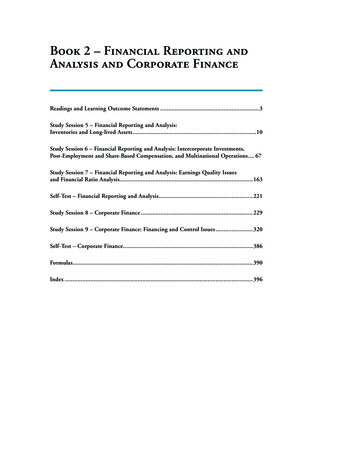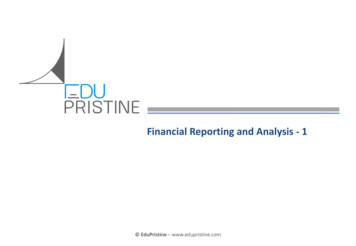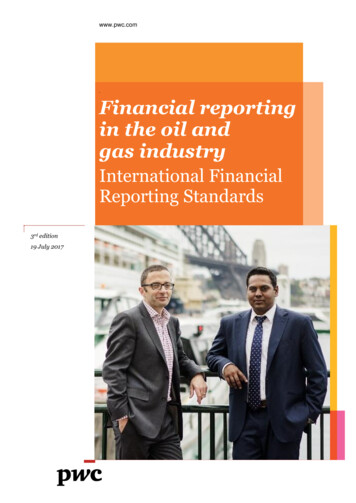
Transcription
www.pwc.comjoFinancial reportingin the oil andgas industryInternational FinancialReporting Standards3rd edition19 July 2017
ContentsIntroduction111Oil and gas value chain and significant accounting issues122Upstream activities132.1Overview132.2Reserves and resources132.2.1 What are reserves and resources?132.2.2 Estimation142.314Exploration and evaluation2.3.1 Successful efforts and full cost methods142.3.2 Accounting for E&E under IFRS 6152.3.3 Initial recognition of E&E under the IFRS 6 exemption162.3.4 Initial recognition under the Framework17Tangible / intangible classification182.3.5 Subsequent measurement of E&E assets182.3.6 Reclassification out of E&E under IFRS 6182.3.7 Impairment of E&E assets192.3.8 Side tracks192.3.9 Suspended wells202.3.10 Post balance sheet events20Identification of dry holes20License relinquishment212.4Development expenditures212.5Borrowing costs222.5.1Foreign exchange gains and losses222.5.2Hedging instruments232.6Revenue recognition in upstream242.6.1Overlift and underlift242.6.2Pre-production sales282.6.3Forward-selling contracts to finance development282.6.4Provisional pricing arrangements292
2.6.5Long-term contracts292.6.6Onerous contracts292.6.7Presentation of revenue302.7Asset swaps312.8Depletion, Depreciation and Amortisation (DD&A)322.8.1UOP basis322.8.2Change in the basis of reserves322.8.3Components332.9Disclosure of reserves and resources342.9.1Overview342.9.2Disclosure of E&E and production expenditure352.9.3SEC rules on disclosure of resources353Midstream and downstream activities373.1Overview373.2Inventory valuation373.2.1Producers’ inventories373.2.2Broker-dealer inventories373.2.3Line fill and cushion gas383.2.4Net realisable value of oil inventories393.2.5Spare part inventories393.3Revenue recognition in midstream and downstream operations403.3.1Product exchanges403.3.2Oil and gas balances403.3.3Cost, insurance and freight versus free on board413.3.4Agency arrangements413.3.5Tolling arrangements423.3.6Oilfield services423.4Emissions trading schemes433.4.1Accounting for ETS433.4.2Certified emissions reductions (CERs)443
3.5Depreciation of downstream assets453.5.1Cost of turnaround/overhaul454Sector-wide accounting issues474.1Business combinations474.1.1Overview474.1.2Definition of a business474.1.3Identifying a business combination504.1.4Acquisition method50Identifying the acquirer and determining the acquisition date50Consideration transferred50Contingent consideration50Allocation of the cost of the combination to assets and liabilitiesacquired51Undeveloped properties / resources51Tax amortisation benefit52Key questions52Goodwill in O&G acquisitions53Goodwill and non-controlling interest53Bargain purchase53Deferred tax54Tax losses544.1.7Provisional assessments of fair values544.1.8Business combinations achieved in stages554.1.9Acquisitions of participating interests in jointly controlled assets554.1.54.1.64.1.10 Restructuring costs574.2Joint arrangements574.2.1Overview574.2.2Joint control574.2.3Classification of joint ventures57Separate vehicles58Joint arrangements not structured through a separate vehicle594
Joint arrangements structured through a separate vehicle59Rights to assets and obligations for liabilities conferred by legal form 59Rights to assets and obligations for liabilities established by contract 60Impact of guarantees on classification of a joint arrangement61‘Other facts and circumstances’61Re-assessment of classification664.2.4Accounting for joint operations (“JOs”)664.2.5Accounting for joint ventures (“JVs”)674.2.6Contributions to joint arrangements674.2.7Investments with less than joint control694.2.8Changes in ownership in a joint arrangement70Changes in ownership – Joint operations70Changes in ownership – Joint ventures71Accounting by the joint arrangement71Accounting by the joint venture71Accounting by the joint operation724.2.94.2.10 Farm outsAccounting by the farmor7272Assets with proven reserves72Assets with no proven reserves73Accounting by the farmee734.2.11 Unitisation agreements754.3Production sharing agreements (PSAs)774.3.1Overview774.3.2Entity bears the exploration risk78Cost capitalisation78Revenue recognition79Entity bears the contractual performance risk81Cost capitalisation criteria81Impairment assessment814.3.35
Revenue recognition814.3.4Decommissioning in PSAs824.3.5Taxes on PSAs83Classification as income tax or royalty83Tax paid in kind85‘Tax paid on behalf’ (POB)854.4Decommissioning854.4.1Decommissioning provisions854.4.2Revisions to decommissioning provisions864.4.3Deferred tax on decommissioning provisions864.4.4Decommissioning funds874.4.5Termination benefits874.5Impairment of development, production and downstream assets884.5.1Overview884.5.2Impairment indicators884.5.3Cash generating units904.5.4Shared assets924.5.5Fair value less cost of disposal (FVLCOD)924.5.6Value in use (VIU)93Period of projections93Commodity prices in VIU93Foreign currencies in VIU94Assets under construction in VIU944.5.7Interaction of decommissioning provisions and impairment testing954.5.8Goodwill impairment testing964.5.9Impairment reversals994.6Royalties and income taxes994.6.1Petroleum taxes – royalty and excise994.6.2Petroleum taxes based on profits994.6.3Taxes paid in cash or in kind1026
4.6.4Deferred tax and acquisitions of participating interests in jointlycontrolled assets1024.6.5Discounting of petroleum taxes1024.6.6Royalties to non-governmental bodies and retained interests1024.7Functional currency1034.7.1Overview1034.7.2Determining the functional currency1034.7.3Change in functional currency1044.8Leasing1054.8.1Overview1054.8.2When does a lease exist?105Use of specific asset105Right to use the specific asset106Reassessment of whether an arrangement contains a lease106Accounting for a lease106Operating lease107Finance lease1074.8.4Presentation and disclosure1074.9Operating segments1074.9.1Overview1074.9.2What is an operating segment?1074.9.3Identifying operating segments: ‘The management approach’1084.9.4Aggregation of operating segments1084.9.5Minimum reportable .8.34.10.1 Control1125Financial instruments, including embedded derivatives1135.1Overview1135.1.1Scope of IAS 391135.1.2Application of ‘own use’1157
5.2Measurement of long-term contracts that do not qualify for ‘own use’ 1165.2.1Day-one profits5.3Volume flexibility (optionality), including ‘Take or pay’ arrangements 1175.4Embedded derivatives1185.4.1Assessing whether embedded derivatives are closely related1195.4.2Timing of assessment of embedded derivatives1195.5LNG contracts1205.6Hedge accounting1205.6.1Principles and types of hedging1205.6.2Cash flow hedges and ‘highly probable’1225.6.3Hedging of non-financial Items1225.6.4Reassessment of hedge relationships in business combinations1225.7Centralised trading units1236First time adoption1256.1Deemed cost1256.2Componentisation1256.3Decommissioning provisions1266.4Functional currency1266.5Assets and liabilities of subsidiaries, associates and joint ventures1276.6Financial instruments1276.7Impairment1276.8Borrowing costs1276.9Disclosure requirements1287New standards – IFRS 9, 15 and 161297.1IFRS 91297.1.1How does classification impact the oil and gas sector?1307.1.2What are the key changes for financial assets?1307.1.3How could current practice change for oil and gas entities?1317.1.4What are the key changes for financial liabilities?1327.1.5Accounting for commodity contracts1331178
7.1.6Hedge accounting1337.2Revenue recognition – IFRS 151347.2.1How does it impact the oil and gas sector?1347.2.2Scope134Definition of a customer135Production sharing arrangements135Product exchanges135Interaction with other standards135Oil and gas balances – overlift and underlift136Scope136Determining the transaction price136Agency relationships137Principal versus agent considerations137Delivery – cost, insurance and freight versus free on board138Cost, insurance and freight (CIF)138Free on board (FOB)139Provisional pricing arrangements139Satisfaction of performance obligations139Determining the transaction price139Take-or-pay and similar long-term supply agreements140Identifying the contract140Breakages1407.2.8Significant financing 7.2.77.2.10 Transition1427.3Leases – IFRS 161427.3.1Scope1427.3.2Identifiable asset1437.3.3Determining whether a contract contains a lease144Interaction between IFRS 15 and IFRS 161489
7.3.4Lease term1487.3.5Recognition and measurement exemptions1497.3.6Lessee accounting149Initial recognition and measurement149Lease payments150Discount rate151Restoration costs151Initial direct costs152Subsequent measurement152Reassessment152Modification of a lease154Decrease in scope154Increase in scope155Change in the lease consideration156Other measurement models156Presentation and disclosures156Lessor accounting157Modification of a tact us10
Introduction11
1. Oil and gas value chain and significant accounting issuesThe objective of oil and gas operations is to find, extract, refine and sell oil and gas, refined productsand related products. It requires substantial capital investment and long lead times to find andextract the hydrocarbons in challenging environmental conditions with uncertain outcomes.Exploration, development and production often take place in joint ventures or joint activities to sharethe substantial capital costs.The outputs often need to be transported significant distances through pipelines and tankers; gasvolumes are increasingly liquefied, transported by special carriers and then regasified on arrival atdestination. Gas remains challenging to transport; thus many producers and utilities look for longterm contracts to support the infrastructure required to develop a major field, particularly off-shore.The industry is exposed significantly to macroeconomic factors such as commodity prices, currencyfluctuations, interest rate risk and political developments. The assessment of commercial viability andtechnical feasibility to extract hydrocarbons is complex, and includes a number of significantvariables. The industry can have a significant impact on the environment consequential to itsoperations and is often obligated to remediate any resulting damage. Despite all of these challenges,taxation of oil and gas extractive activity and the resultant profits is a major source of revenue formany governments. Governments are also increasingly sophisticated and looking to secure asignificant share of any oil and gas produced on their sovereign territory.This publication examines the accounting issues that are most significant for the oil and gas industry.The issues are addressed following the oil and gas value chain: exploration and development,production and sales of product, together with issues that are pervasive to a typical oil and gas entity.Upstream activities Reserves and resources Depletion and depreciation of upstreamassets Exploration and evaluation Development expenditures Borrowing costs Revenue recognition Disclosure of reserves and resources Production sharing agreements andconcessionsMidstream and downstream activities Product valuation issues Revenue recognition issues Emission trading schemes Depreciation of downstream assetsSector-wide issues: Business combinationsJoint venturesDecommissioningImpairmentRoyalty and income taxesFunctional currencyLeasingFinancial instruments12
2. Upstream activities2.1 OverviewUpstream activities comprise the exploration for and discovery of hydrocarbons; crude oil andnatural gas. They also include the development of these hydrocarbon reserves and resources, andtheir subsequent extraction (production).2.2 Reserves and resourcesThe oil and gas natural resources found by an entity are its most important economic asset. Thefinancial strength of the entity depends on the amount and quality of the resources it has the rightto extract and sell. Resources are the source of future cash inflows from the sale of hydrocarbonsand provide the basis for borrowing and for raising equity finance.2.2.1 What are reserves and resources?Resources are those volumes of oil and gas that are estimated to be present in the ground, whichmay or may not be economically recoverable. Reserves are those resources that are anticipated to becommercially recovered from known accumulations from a specific date.Natural resources are outside the scope of IAS 16 Property, plant and equipment and IAS 38Intangible assets. The IASB is considering the accounting for mineral resources and reserves aspart of its Extractive Activities project.Entities record reserves at the historical cost of finding and developing reserves or acquiring themfrom third parties. The cost of finding and developing reserves is not directly related to the quantityof reserves. The purchase price allocated to reserves acquired in a business combination is the fairvalue of the reserves and resources at the date of the business combination but only at that point intime.Reserves and resources have a pervasive impact on an oil and gas entity’s financial statements,impacting on a number of significant areas. These include, but are not limited to: depletion, depreciation and amortisation;impairment and reversal of impairment;the recognition of future decommissioning and restoration obligations; andallocation of purchase price in business combinations.The geological and engineering data available for hydrocarbon accumulations will enable anassessment of the uncertainty/certainty of the reserves estimate. Reserves are classified as proved orunproved according to the degree of certainty associated with their estimated recoverability. Theseclassifications do not arise from any definitions or guidance in IFRS. This publication uses terms asthey are commonly used in the industry but there are different specific definitions of reserves, andthe dete
7.3.6 Lessee accounting 149 Initial recognition and measurement 149 Lease payments 150 Discount rate 151 Restoration costs 151 Initial direct costs 152 Subsequent measurement 152 Reassessment 152 Modification of a lease 154 Decrease in scope 154 Increase in scope 155 Change in the lease consideration 156 Other measurement models 156File Size: 1MBPage Count: 159





